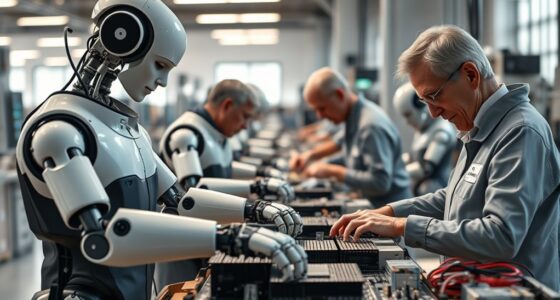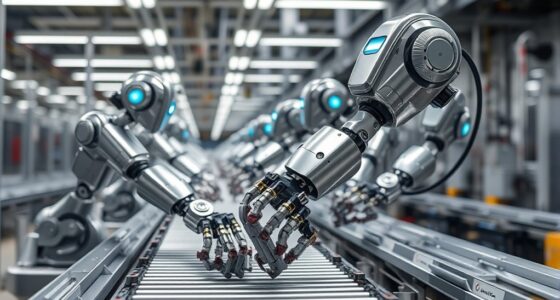To shift from threatened roles to AI-proof paths, focus on gaining versatile skills and industry-relevant certifications, especially in growing fields like healthcare, renewable energy, and tech. Prioritize continuous learning and consider lateral moves that build your skill set. Roles that emphasize problem-solving, creativity, and emotional intelligence are less automation-prone. Staying adaptable and proactive in your career strategies can open doors to resilient, future-proof opportunities—more tips to help you make a successful transition await you.
Key Takeaways
- Focus on developing transferable skills like critical thinking, creativity, and emotional intelligence that AI cannot easily replicate.
- Pursue certifications and short-term training in emerging fields such as renewable energy, healthcare, or cybersecurity.
- Leverage lateral moves within industries to acquire versatile skills and broaden your career options.
- Embrace continuous learning and stay adaptable to quickly pivot into growing, future-proof sectors.
- Network strategically and seek mentorship in high-growth industries to identify new opportunities early.

Are you considering a career switch but unsure where to start? You’re not alone. With industries like retail, hospitality, tech, and administrative services seeing high employee turnover—sometimes over 45%—many workers are rethinking their paths. Notably, finance and insurance sectors have 65% of employees leaving entirely, while public and social sectors report a staggering 72% job departure rate. This turbulence signals it’s a prime time to explore new opportunities, especially in sectors poised for growth. The healthcare and social assistance industries are projected to add 2.3 million jobs between 2023 and 2033, growing at a 10% rate. Renewable energy fields like solar and wind power are exploding, with solar employment expected to surge nearly 276%, and wind energy expanding over 115%. Tech and IT roles are also booming, outpacing average employment growth, making them attractive options for those seeking stability and future-proof careers.
Current job market trends reflect this shift. About 28% of professionals plan to change companies within the next year, and over half are contemplating or actively planning career moves. This increased mobility is partly driven by record-low employer satisfaction, fueling what some call the “Great Detachment” of workers. Interestingly, new-collar roles—positions that prioritize skills over traditional degrees—are gaining traction, especially in tech and healthcare. These roles often require specific certifications or short-term training, making it easier to pivot without lengthy educational commitments. Meanwhile, stagnant wages and a cooling job market push many to explore alternative paths, often necessitating a strategic approach.
Understanding tenure patterns can help you plan your transition. Managers and professionals typically stay about 5.5 years in a role, while service workers tend to move every 3.2 years. Early-career workers, aged 25–34, tend to switch jobs roughly 2.4 times before stabilizing, emphasizing the importance of gaining versatile skills early on. Shorter tenures in roles like sales—often 6 to 18 months—highlight the need for agility, while longer-term commitments in tech roles demand extended preparation, sometimes over three years, for senior positions. These patterns reveal that rapid career pivots are common, especially with cross-skilling or obtaining relevant certifications.
Early-career workers switch jobs an average of 2.4 times, highlighting the importance of versatile skills and adaptability.
To navigate this landscape, focus on acquiring skills demanded in growth sectors. Renewable energy tech, healthcare technology, cloud infrastructure, and cybersecurity are becoming essential. Certifications and credentials often outweigh traditional degrees in these fields, making skill-based hiring more prevalent. Internal promotions in tech and product management also demonstrate that climbing the ladder often involves lateral moves and skill enhancement rather than linear progression. Whether you’re jumping industries or climbing within your current one, understanding these dynamics will help you make informed, strategic decisions, ensuring your career remains resilient against automation and industry upheavals. The key lies in continuous learning and adaptability—your best tools for transforming threats into opportunities.
Frequently Asked Questions
How Do I Identify Ai-Proof Careers Suited to My Skills?
To identify AI-proof careers suited to your skills, start by evaluating what makes you uniquely human—empathy, creativity, hands-on skills. Look for roles in healthcare, skilled trades, or education that require emotional intelligence or physical dexterity. Consider your soft skills like communication and problem-solving, then explore fields that value these qualities. Upskilling in related areas and networking in resilient industries will help you shift smoothly into a sustainable, AI-proof career.
What Are the Initial Steps to Transition Careers Confidently?
Starting a career shift is like setting sail on unfamiliar waters—you need a clear map. Begin by identifying your transferable skills, like communication or problem-solving. Research industries with growth potential, such as healthcare or renewable energy. Pursue relevant certifications or online courses to upskill. Network actively within target sectors for insights and opportunities. Finally, choose roles with shorter training cycles for faster progress, building confidence as you navigate this new path.
How Long Does It Typically Take to Switch to an Ai-Proof Role?
Switching to an AI-proof role usually takes 12 to 24 months, depending on your prior experience and the industry. You’ll need to develop technical skills like AI frameworks and data analysis, often through online courses. Engaging in industry-specific knowledge and collaborating with AI teams accelerates your progress. Keep updating your skills regularly and focus on human-centric roles such as teaching or counseling, which are less susceptible to automation.
What Resources Can Help Me Learn New Skills Quickly?
Did you know that microlearning boosts retention by up to 80%? When you want to learn new skills quickly, focus on targeted resources like online courses, tutorials, and interactive platforms. Prioritize practical application and short, focused sessions to prevent burnout. Use spaced repetition tools, seek feedback, and stay consistent. These resources and strategies help you master new skills efficiently, preparing you for AI-proof roles faster.
How Do I Handle Fear and Uncertainty During a Career Change?
You face fear and uncertainty when changing careers, but you can handle it by shifting your mindset. Embrace failure as a learning step, and see uncertainty as opportunity. Build your confidence through proactive planning, like diversifying skills and creating an emergency fund. Connect with others in your target field through networking, and focus on what you can control. Remember, taking small, deliberate steps reduces anxiety and builds resilience.
Conclusion
By embracing change, by seeking growth, and by staying adaptable, you turn threatened roles into resilient careers. You recognize opportunities, you develop new skills, and you forge AI-proof paths. You refuse to stay stagnant, instead choosing progress, evolution, and empowerment. In doing so, you transform uncertainty into confidence, obstacles into stepping stones, and doubts into determination. Remember, your future isn’t written by machines—it’s shaped by your willingness to evolve and excel beyond the status quo.









